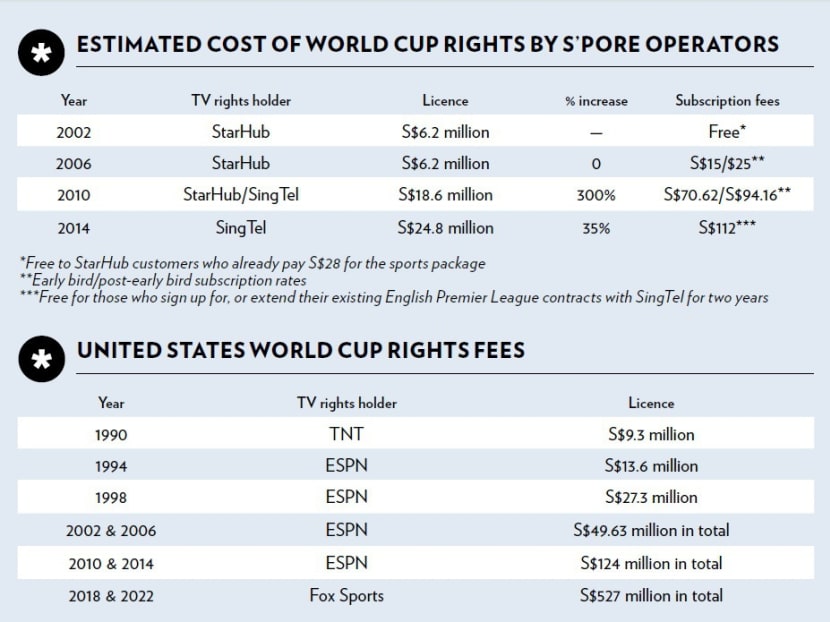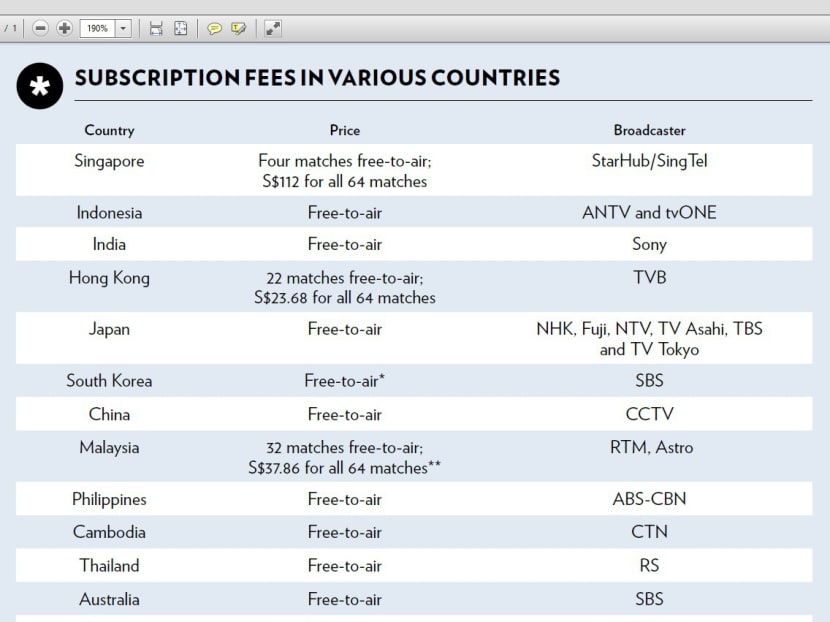Prepare to pay more to watch 2018 world cup
SINGAPORE — If you think watching the World Cup from Brazil in 2014 has been expensive, brace yourself for what could come in four years’ time.


SINGAPORE — If you think watching the World Cup from Brazil in 2014 has been expensive, brace yourself for what could come in four years’ time.
For at least 100,000 fans, who watched the month-long football extravaganza on pay-television from the comfort of their homes, the privilege cost them S$112, unless they got it free, as subscribers of SingTel’s mio TV Gold Pack service.
Since SingTel snared the English Premier League rights from 2011 to shore up its subscriber base, the cost of watching the World Cup on TV has risen dramatically.
This year, it cost five times and 20 per cent more than in 2006 and 2010, respectively.
For the next World Cup in Russia in 2018, whether it is delivered by StarHub or SingTel, signs are that it will cost even more. This is caused chiefly by the rising cost of TV rights, especially in territories where rival operators are bidding.
With TV rights forming the bulk of FIFA’s World Cup revenues, with US$4 billion (S$4.9 billion) the forecast for this year’s tournament revenue, it is in the interest of football’s governing body to keep prices up. Countries such as Singapore and the United States — where incomes are high and competition keen — present opportunities for the sport’s marketing agents to sell it at a premium.
Ultimately, it is the consumer who bears the brunt of the escalating prices, and in Asia, it is costliest in the Lion City.
For political reasons, such as in Thailand and Vietnam, the respective governments foot the bill and beam the matches free. Elsewhere, the fees are shared between broadcasters or the markets are big enough for free-to-air television to cover the costs through advertising.
Analyst Aravind Venugopal of Media Partners Asia told TODAY that with advertising expenditure rising, FIFA has hit the jackpot.
“There have been few instances of a downward trend in rights fees for sports properties worldwide and FIFA tallies this with the increase in television advertising revenues of broadcasters who bid for the World Cup, especially in South-east Asia,” said Aravind.
“This takes on another dimension where there are competing pay-TV operators in a territory who use the World Cup as a means to try to attract more subscribers to their services, resulting in sports rights costs escalations.”
Intense competition for new signees between SingTel and StarHub is primarily responsible for the spike in the World Cup rights fees.
Although it has never been officially revealed, it was widely reported that both put in a joint-bid of US$15 million for the 2010 edition, an increase of 300 per cent over StarHub’s outlay in 2006.
It is estimated that SingTel forked out 35 per cent more than the previous World Cup in bidding for exclusive rights this year.
This trend mirrors that of the United States, where Fox Sports paid US$425 million for the 2018 and 2022 World Cups in their strategy to outperform ESPN, which splashed US$100 million for the current tournament and the last one in South Africa.
Forrester Research senior analyst Clement Teo said the cost of competition ultimately has a bearing on how much the consumer pays to watch the matches.
“In 2006, when content delivery was through one operator, StarHub, the cost of acquiring the rights could be subsidised through exclusive advertising on their channels, among other things. The operator was also able to sell their entertainment packages to subscribers who paid for the sports channels to watch the World Cup. This goes some way to recouping the cost for the television rights.”
The cost of those rights, currently in excess of US$20 million, has excluded MediaCorp from bidding. With the increased pricing of each tournament, a spokesperson explained why it has not shown the entire tournament in 16 years: “MediaCorp aired the World Cup matches on free-to-air TV in 1998, as the licensing fees and the business environment were favourable then.”
The national broadcaster does not have a subscriber base to lean on, given that advertising revenues from the competition would fall far short of covering costs.
Until both rival pay-TV operators are comfortable with their customer base numbers, it seems consumers will not be immune to price increases.
FIFA will wait until they are able to clinch the best deal possible, even delaying a deal at the eleventh hour. This has an impact on an operator’s ability to snag advertising deals, which in turn lower the consumer’s cost.
Aravind explained: “SingTel announced its deal only in March and had less than three months to secure deals. It was too late because advertisers would have already decided what to do with their budgets. Most operators in other countries have more than six months to do this.”
TABLE 1
Estimated cost of the World Cup rights by Singapore operators
Year TV rights holder Licence % increase Licence increase
2002: StarHub US$5 million - Free*
2006: StarHub US$5 million 0 $15/$25**
2010: StarHub/SingTel US$15 million 300% $70.62/$94.16**
2014: SingTel US$20 million 35% $112 ***
* Free to StarHub customers who already pay $28 for the sports package
** Early bird/post-early bird subscription rates
*** Free for those who sign up for or extend their existing English Premier League contracts with SingTel for two years.
TABLE 2
United States World Cup rights fees
Year TV rights holder Licence
1990 TNT US$7.5 million
1994 ESPN US$ 11 million
1998 ESPN US$ 22 million
2002 & 2006 ESPN US$ 40 million total
2010 & 2014 ESPN US$ 100 million total
2018 & 2022 Fox Sports US$ 425 million total
TABLE 3
FIFA’s World Cup revenues
Year World Cup revenue TV rights income
2002 US$ 1.3 billion US$1.1 billion
2006 US$3.6 billion US$2 billion
2010 US$3.65 billion US$2.41 billion
TABLE 4
Country Price Broadcaster
Singapore 4 matches free-to-air StarHub/SingTel
S$112 for all 64 matches
Indonesia Free-to-air ANTV and tvONE
India Free-to-air Sony
Hong Kong 22 matches free-to-air TVB
$23.68 for all 64 matches
Japan Free-to-air NHK, Fuji, NTV, TV Asahi,
TBS, and TV Tokyo
South Korea Free-to-air* SBS
China Free-to-air CCTV
Malaysia 32 matches free-to-air RTM, Astro
S$37.86 for all 64 matches**
Philippines Free-to-air ABS-CBN
Cambodia Free-to-air CTN
Thailand Free-to-air RS
Australia Free-to-air SBS
Vietnam Free-to-air VTV
*Matches that have overlapping kick-off times to be aired on pay service SBS Cable
**Free for existing ASTRO sports package subscribers





